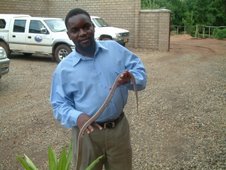
This article appeared in the Sunday Times of June 5, 2005
A one year stock-taking on our environmentSince 1972 June 5, every year is World Environmental Day (WED), a day set aside by the United Nations as one of the principal vehicles through which nations the world over should stimulate awareness of the environment and enhance political attention and action.
Today Malawi joins the international community in commemorating the day under the global theme “Green Cities” and the slogan is “Plan for the Planet!” Locally the theme has been narrowed down to “Keep our cities Green and Clean”. Environmental journalist
HASTINGS MALOYA ponders on the theme in relation to challenges facing our cities and towns.
Once upon a time, people leaving in and around the cities of Lilongwe and Blantyre had pride in the free flows of Lilongwe, Lingazi, Mudi, Limbe and Likhubula rivers, just to mention but a few. Women would do much of their laundries in the rivers while children would spend afternoons playing in the waters, of course learning the art of swimming. Others would enjoy the rare trade of fishing from the rivers while others would use them as a source of water for small scale irrigation.
The same was the case in other towns like Zomba and Mzuzu where availability of water in the rivers did not only ease house chore activities but also added beauty to the towns especially with the provision of wonderful vegetation in the river banks that made towns look green and beautiful..
With its beautiful trees and flowers, the City of Blantyre was once known worldwide due to its cleanliness and caring residents. There were designated places where one would litter and refuse collection was order of the day. Today it is a completely changed situation, not only in Blantyre but in all our cities, towns and districts. Litter is everywhere, surely an eyesore and residents seem they mind very little of how they should manage waste. The rivers that people used to be proud of now have no water and are a supply of pungent smells following piles and piles of waste.
The rivers are polluted and this has led to inadequate access to safe drinking water and cause to different sicknesses. Another hitch is lack of proper sanitation facilities and overcrowded conditions in our cities and towns due to unplanned expanded settlements which pose a high risk of communicable diseases and caused additional pressure on management of waste. We continuously witness residents dispose waste in a lamentable manner. Our towns and cities today are no longer a pleasant sight – yes they are full of waste. This is not only bad to our health but to our environment too. No body can claim to be happy with the current situation.
We can fairly define waste as leftovers after products have been made by producers and have been used by consumers. Waste can be quite hazardous to the health of humans as well as plants and animals. Common waste in domestic garbage include cans, bottles, cardboard and paper, plastic, and rotting organic material.
Much waste in a form of volume of garbage in our cities and towns come from our own homes, offices and schools. Packaging of the products sold in most shops has also been another cause of the pathetic situation that our cities are in today. Of late there has been a lot of paper being distributed from shops in the form of carrier bags but which have not been carefully disposed after use.
Most of our industries lack responsible strategies for dealing with the waste by-products of their manufacturing processes. And not much has been said in condemning the production and release of waste from industries simply because industries have been looked at as an engine for economic growth and a starting place of development. We have therefore ended up living in very a very polluted environment in our quest to support industrial growth.
And our towns cities and districts lack regular waste collection services hence we have noticed garbage building up on road sides, footpaths and vacant land, especially along river banks. With little understanding, knowledge and awareness we have let things happen the way they do without raising much concern. Sometimes we have only complained within ourselves while situations continue to deteriorate.
Most unfortunately this appalling situation comes after peoples’ realisation that the traditional reliance on landfill as a method of disposal can create its own set of problems. In the first place, landfills take up space which in most cases, especially in cities and towns, is very valuable. Secondly, landfills can eventually 'leak' - releasing a toxic mix of rainwater and decomposing waste into the soil and groundwater.
However, all is not lost yet. Commemoration of the World Environment Day should open up new horizons and give us an opportune time to take stock of the environment that we live in. It should be a people's event to promote an understanding that we have a responsibility to changing attitudes towards management of our surroundings. The day should be used to advocate means of ensuring that people enjoy a safer living environment. On this day, it would be imperative for us to examine the state of our environment and seriously consider actions which each of us must take with a sober mind and quiet confidence.
It also takes people in responsible positions in our cities and towns to measure their performance against the environmental situation of their responsible towns and cities. It should be a shame for a responsible officer to be seen in the city jumping up and down in the streets trying to avoid piles of waste or when an officer witnesses minibus commuters throwing litter through windows.
For example, in his message on the commemoration of the day, Governor of California State in the US, Mr. Arnold Schwarzenegger has promised to passionately commit himself to defending California's environment, and providing real leadership to protect its precious land, air and water.
“Here in California, we have rejected the notion that we must choose between protecting the environment, and protecting jobs and economic growth. We know that if our beaches are soiled by oil spills, tourists will not experience the wonders of our magnificent coastline. If we log our forests irresponsibly, streambeds will be destroyed and our fishing industry will suffer”, says the well known film star of the Terminator fame.
And the California Governor advises: “If we are going to leave a better planet for generations to come, we must work within a global effort to ensure the economy and the environment never become competing interests”. It is encouraging and indeed exciting when people whom we have known most in the entertainment or rather in political circles make positive comments in relation to the day.
To us, this day should be for stock taking. Let us accept that we have done much damage to our environment and we have lost the pride of having beautiful towns and cities. We have irresponsibly turned our towns and cities as dumping grounds. But all in all, we are ready to reverse the situation.
For a while, let us look at the environment as our surroundings and check whether we are using our natural resources in a sustainable manner and how we dispose unwanted materials in our daily living. This will give a human face to environmental issues and we would empower ourselves to becoming active agents of environmental management as an aspect of development.
The media has a big role to play. As observed recently by the deputy minister of mines, natural resources and environmental affairs Sidik Mia environment is a key component of the country’s sustainable development. Mia bemoaned lukewarm reporting on environment by Malawian journalists and urged them to report more observing that the media is a better channel that would enable people and institutions to appreciate serious environmental problems facing the country.
“One of the deficiencies identified in achieving the noble task of informing and educating Malawians, is lack of proper reporting and sufficient coverage of issues that matter,” observed Mia.
Malawi also lacks environmental education. Environment should be considered as a subject in the curriculum so that school going children whether in kindergarten, primary or secondary are instilled with environmental issues at a tender age. They definitely would grow while appreciating the environment that they live in and taking steps to jealously gourd it.
For government, the observance of the World Environment Day should provide an opportunity to establish permanent government structures dealing with environmental management and economic planning for sustainable and equitable development. So far the Malawi Government has done considerable strides on the environmental management. A lot of policies in line with good environmental management have been produced.
Through the Department of Environmental Affairs the government has facilitated the production of district and national State of Environment Reports and Environmental Action Plans. While State of Environment Reports enlighten environmental situations, Action Plans provide strategies and directions on management.
However, we cannot talk of environmental management as an achievement relating to the production of reports or plans or policy reviews alone. These documents may be useless unless information contained in them is put to better use. Considering the state of our cities and towns today, the need for empowerment and instillation of ownership among residents cannot be overemphasized.
It is only unfortunate that the concept of the environment is fairly new and this presents a challenging task to sensitize people on the effects of poor waste management and ideas of sustainability. However, it only takes us to acknowledge that we are the custodians of places that we live in and it is our responsibility to care for our environment.
Many people view their environment as solely natural resources to benefit from and rarely question the aftermath effects of overuse or abuse of resources. It’s also very difficult to change ones mentality if benefits cannot be seen immediately with the proposed change. One must also appreciate issues of poverty and livelihoods and that people are not deliberately trying to destroy their environment but rather they are trying to survive in the short term.
As we join the international community in observing the day, we have a challenge to mend our situation. After reading this piece, look at your surrounding – if you are not happy the way it is, what do you think should be done? And who should do it? Surely it is yourself.














